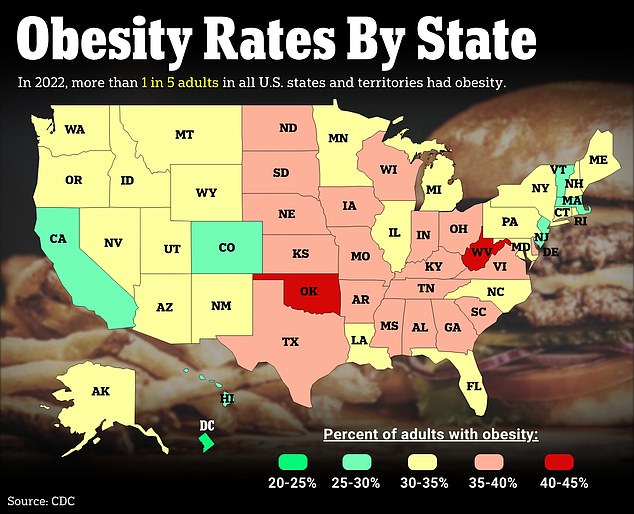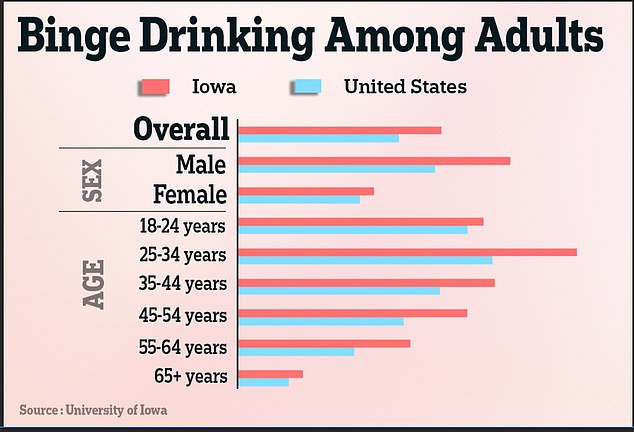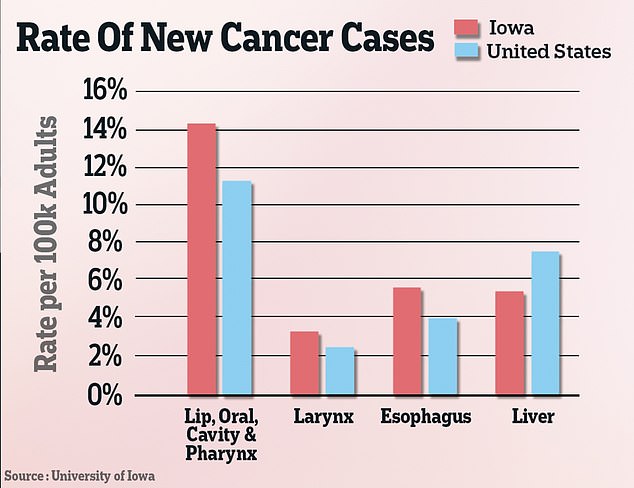Researchers studying a sharp rise in cancers in Iowa have focused on a number of factors that have made the state the unlikely epicenter of new cases in the United States.
The state has the fastest growing rate of new cancers and the second highest cancer rate in the country for the second year in a row.
This trend baffled many Midwesterners and officials because neighboring states, with similar demographics and agricultural practices, actually experienced a decline in cancer rates.
But now officials point to a single environmental cause for the increase.
It may have to do, at least in part, with a geographic anomaly: radioactive gas leaking from Earth thanks to geological changes that took place during the last ice age.
Each year, the Iowa Cancer Registry and the University of Iowa release a report on how the state’s cancer cases align with the rest of the country.

Pesticide use is one of five factors likely contributing to the rise in cancer cases in Iowa, officials say.
Radon, a natural gas released from eroded bedrock, is the number one cause of lung cancer in non-smokers according to the Environmental protection agency (EPA).
Thousands of years ago, Iowa and other parts of the Midwest were covered by a gigantic glacier that began to erode that bedrock. Today, it is weathered enough in specific areas that it can leach into the ground and reach people’s homes.
Experts have now identified five potential factors why lung, breast, prostate and skin cancers are increasing at high rates across the Hawkeye State: obesity, radon exposure, tobacco habits, agricultural practices and alcohol consumption.
The interaction of these five factors is likely to blame for this cancer crisis, said Mary Charlton, director of the Iowa Cancer Registry and professor in the Department of Epidemiology at the University of Iowa College of Public Health. told the Telegraph Herald.
“The unfortunate and unsatisfactory answer I have for everyone is that it’s not one thing,” Dr. Charlton said. ‘It just can’t be. We have so many different types of cancer, and they all have different patterns, different geographic patterns, different populations.’
Two in five Iowans will be diagnosed with cancer, according to the Iowa Cancer Report 2024. This is approximately 21,000 new cases, of which 6,100 people are expected to die.
The state currently exceeds the national average in the number of new cancer diagnoses, with approximately 480 new cases per 100,000 people, compared to the national average of 442 per 100,000.
In recent years, people have become aware of how environmental factors, such as pesticide use, could increase the risk of cancer, especially in rural areas.
It is likely, experts said, that pesticide and fertilizer use plays a role in Iowa’s cancer cases. After all, the state uses more agricultural chemicals than any other: stockpiling 237 million pounds of herbicides and 11, 6 billion pounds of fertilizer a year.
When these chemicals enter the water supply, they can accumulate in the human body and have been linked to cancers of the immune system, brain, breast, bladder, liver, bile ducts, and ovaries.
But other environmental factors, such as radon, could be equally important, the Telegraph Herald reported.
Radon is a naturally occurring radioactive gas that is produced when rocks and soil weather.
When giant glaciers covered the entire Midwest during the last ice age, they began scraping away at the rocks and other surfaces that covered this large, flat region.
Those same rocks have weathered enough that they are now releasing small amounts of gas into the ground throughout the Midwest, particularly in Iowa.
From the ground, radon can enter your home, Iowa Department of Health and Human Services warned. It can sneak through small holes made for wiring, service pipes, or cracks in a building’s foundation, where it accumulates undetected unless the space is equipped with radon testing kits.
When someone inhales high levels of radon gas, it damages the lining of their lungs, causing mutations that can eventually develop into cancer. reported the National Cancer Institute.
According to the EPA, about 70 percent of homes in Iowa are at risk of radon exposure.
In nonsmokers, radon is the leading cause of lung cancer, the EPA reports. Another factor Iowa officials are taking note of is obesity.

Obesity has been linked to multiple types of cancer. In Iowa, an average rate of obesity and other factors, such as alcohol consumption and radon exposure, combine to raise overall cancer rates in the state.

One of the risk factors that officials believe may be contributing to cancer cases in Iowa is the drinking habits of the average Iowan.
About 37 percent of Iowa adults are obese. That’s on par with national averages, where 41.9 percent of American adults were obese in 2023, according to the Trust for America’s Health.
The incidence of obesity could increase Iowans’ overall risk, pushing them into the high-rate category.
Obesity has been identified as a risk factor for liver, kidney, gastric, breast, throat, thyroid and ovarian cancer, among others, according to the National Cancer Institute.
“Overweight and obesity represent a public health crisis and any cancer prevention strategy must include effective weight loss strategies,” Dr. Andrew Nish, said an interventional radiologist and director of the John Stoddard Cancer Center in Iowa.
Most studies that have discovered this link have been observational, meaning scientists cannot definitively prove that obesity causes cancer. But the link is strong in some types of disease.
For example, people with severe obesity are seven times more likely to develop endometrial cancer, which affects the uterus, than people with a standard BMI.
There are several theories for this.
One is that obesity sometimes causes the body to suffer from frequent inflammation, the NCI reported. Constant inflammation can stress the body’s cells, causing DNA damage, which in turn can lead to cancer.
Another theory is that fatty tissue produces estrogen. Too much estrogen over a long period of time has been linked to several types of cancer, the NCI reported.
Officials also stressed the need to stay away from well-known risk factors such as alcohol and tobacco.
Dr. Charlton noted that although smoking habits have been trending downward in Iowa, the state has been slower to ditch cigarettes than the rest of the country.
In 2021, 14 percent of Midwesterners reported smoking, compared to 11.5 percent of all Americans, the Telegraph Herald reported.
Drinkers are five times more likely to develop throat or mouth cancer than non-drinkers, according to the study. Iowa Cancer Report Card 2024, Report Says. Liver, throat, colorectal, lip, oral and breast cancers.
About 22 percent of Iowans drink excessively, compared to 17 percent of Americans nationwide.
‘Compared to other states, more Iowans drink and in larger quantities. This may be why Iowa has the fourth-highest incidence of alcohol-related cancers in the U.S. and the highest rate in the Midwest,” according to the 2024 Cancer in Iowa report.
Taking these five factors into account may help explain why new types of cancer are on the rise in different corners of the state, Mary Rose Corrigan, public health director for the city of Dubuque in Iowa, told the Telegraph Herald.
“There are many things that contribute to it together, and it all comes down to lifestyle, access, our environment and the policies that help people have healthy lifestyles,” Ms Corrigan said.

